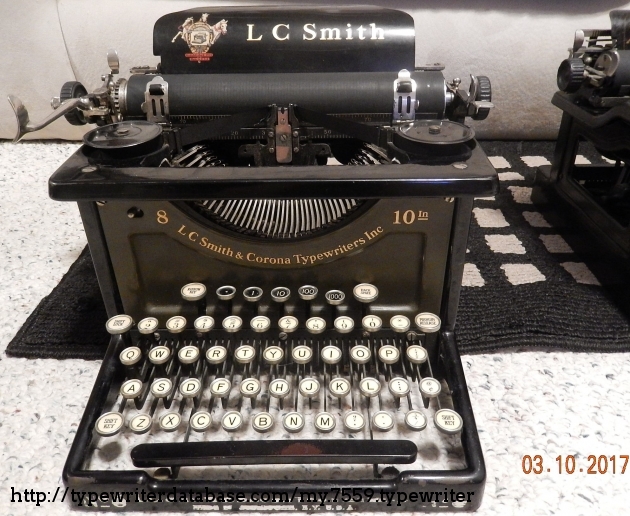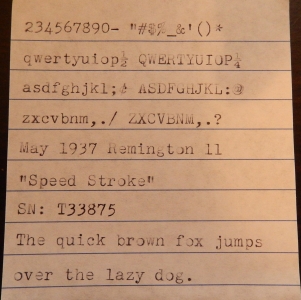- OliverNo.9
- Touch Typist
 Offline
Offline 
- From: CT
- Registered: 02-4-2016
- Posts: 140
Remington 11 "Short-Stroke"/"Speed-Stroke"
Hello all, I have a 1937 Remington 11 "Short-Stroke"/"Speed-Stroke" and I have been trying to figure out how to make the type quality better. I have tried multiple sheets of paper, that did not help much. I have tried the dial on the front in different positions and that did not help. Recently, I read a post on this site saying to use a calculator ribbon in noiseless style machines. This helped a little, but the type quality is still lacking.
I like using this machine but the type quality keeps me from really using it. Does anyone have any suggestions on how to make the quality better?
I have had three Noiseless/noisy-noiseless machines and all of them have had this problem, but then I have seen other Noiseless/noisy-noiseless machines that type very well.
Thank you in advance, OliverNo.9
- Uwe
- Moderator
 Offline
Offline 
- From: Toronto, Canada
- Registered: 12-3-2013
- Posts: 4,410
Re: Remington 11 "Short-Stroke"/"Speed-Stroke"
Any chance you could post a type sample so we can see exactly what it's doing and what you're unhappy with?
This topic should technically be moved to the Maintenance and Repairs sub-forum, but given this might lead to a more general discussion concerning the type quality of Quiet/Noiseless/Silent models, I'll leave it here.
The pronoun I has always been capitalized in the English language for more than 700 years.
- OliverNo.9
- Touch Typist
 Offline
Offline 
- From: CT
- Registered: 02-4-2016
- Posts: 140
Re: Remington 11 "Short-Stroke"/"Speed-Stroke"
Uwe wrote:
Any chance you could post a type sample so we can see exactly what it's doing and what you're unhappy with?
This topic should technically be moved to the Maintenance and Repairs sub-forum, but given this might lead to a more general discussion concerning the type quality of Quiet/Noiseless/Silent models, I'll leave it here.
Uwe, Thank you for the response. I apologize for putting this in the wrong spot. I will post a type sample soon. Thank you very much.
OliverNo.9
- •
- OliverNo.9
- Touch Typist
 Offline
Offline 
- From: CT
- Registered: 02-4-2016
- Posts: 140
Re: Remington 11 "Short-Stroke"/"Speed-Stroke"
This is a type sample of my Remington 11 "Short-Stroke"/"Speed-Stroke."
- •
- thetypewriterman
- Key Master
 Offline
Offline - From: Leiston, England
- Registered: 29-5-2013
- Posts: 942
Re: Remington 11 "Short-Stroke"/"Speed-Stroke"
OK - A little checklist - Is the platen hard ? Might the machine have been dropped in the past, affecting the platen/anvil (ring/cylinder) setting ? The 'o' is heavy on the right, so my guess is that typebar at least is very slightly twisted. Generally, the type saple is too light at the top, so maybe the 'on feet' adjustment is out. However, my money is on the first and second options.
- thetypewriterman
- Key Master
 Offline
Offline - From: Leiston, England
- Registered: 29-5-2013
- Posts: 942
Re: Remington 11 "Short-Stroke"/"Speed-Stroke"
An edit - You can get away with a much harder platen than normal on a noiseless because the impact pressure is a lot less than on a standard manual. So on second thoughts, it is more likely to be platen/anvil. These machines are not as 'adjustable' as a standard manual so you might be stuck wih the light print. You could also try adding some METAL STAMP INK (not rubber stamp ink) to a part of the ribbon as an experiment to see it it improves matters.
- OliverNo.9
- Touch Typist
 Offline
Offline 
- From: CT
- Registered: 02-4-2016
- Posts: 140
Re: Remington 11 "Short-Stroke"/"Speed-Stroke"
thetypewriterman wrote:
An edit - You can get away with a much harder platen than normal on a noiseless because the impact pressure is a lot less than on a standard manual. So on second thoughts, it is more likely to be platen/anvil. These machines are not as 'adjustable' as a standard manual so you might be stuck wih the light print. You could also try adding some METAL STAMP INK (not rubber stamp ink) to a part of the ribbon as an experiment to see it it improves matters.
thetypewriterman wrote:
OK - A little checklist - Is the platen hard ? Might the machine have been dropped in the past, affecting the platen/anvil (ring/cylinder) setting ? The 'o' is heavy on the right, so my guess is that typebar at least is very slightly twisted. Generally, the type saple is too light at the top, so maybe the 'on feet' adjustment is out. However, my money is on the first and second options.
thetypewriterman, thank you for the advice. The machine does not seem to have ever been dropped, but you never know.
I am still a novice when it come to certain aspects of typewriters, when you mention the platen/anvil setting, is this the adjustment for the way the typebars hit the platen?
Thank you very much.
OliverNo.9.
- •
- thetypewriterman
- Key Master
 Offline
Offline - From: Leiston, England
- Registered: 29-5-2013
- Posts: 942
Re: Remington 11 "Short-Stroke"/"Speed-Stroke"
On a 'normal' typewriter, the typebar strikes the anvil fractionally before the type reaches the paper. Of course, the noiseless is a whole different ball-game. I'm sure that I have seen a downloadable Remington Noiseless service manual on the internet somewhere. If I can find it, I'll come back with a location so that you can read it for yourself. The noiseless wasn't well-liked in the typewriter trade because it is not like a 'normal' typewriter and most engineers didn't know much about it. I still don't know as much as I'd like to, purely because I see them so infrequently. The strange co-incidence is that I have been working on one this afternoon for a film job. I bet you didn't know that Winston Churchill insisted on his secretary using one whilst he dictated his letters ! You learn something new every day !
- OliverNo.9
- Touch Typist
 Offline
Offline 
- From: CT
- Registered: 02-4-2016
- Posts: 140
Re: Remington 11 "Short-Stroke"/"Speed-Stroke"
thetypewriterman wrote:
On a 'normal' typewriter, the typebar strikes the anvil fractionally before the type reaches the paper. Of course, the noiseless is a whole different ball-game. I'm sure that I have seen a downloadable Remington Noiseless service manual on the internet somewhere. If I can find it, I'll come back with a location so that you can read it for yourself. The noiseless wasn't well-liked in the typewriter trade because it is not like a 'normal' typewriter and most engineers didn't know much about it. I still don't know as much as I'd like to, purely because I see them so infrequently. The strange co-incidence is that I have been working on one this afternoon for a film job. I bet you didn't know that Winston Churchill insisted on his secretary using one whilst he dictated his letters ! You learn something new every day !
thetypewriterman, thank you for your advice! It is funny, I keep hearing that these noiseless-type machines were not well liked, but I do not mind them... I am just not a fan of their print quality!
That is an interesting coincidence about you are working on a noiseless!
Thank you for telling me that fact about Winston Churchill, I love learning facts like that!
Thank you again for your help!
OliverNo.9.
- •

 1 of 1
1 of 1